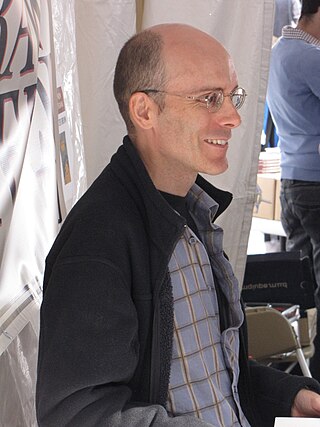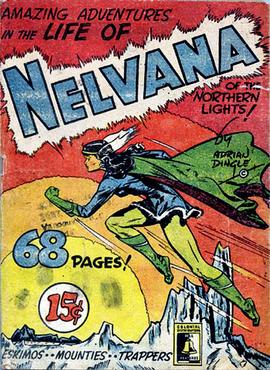Related Research Articles

Nelvana Enterprises, Inc. is a Canadian animation studio and entertainment company owned by Corus Entertainment. Founded in July 1971 by Michael Hirsh, Patrick Loubert and Clive A. Smith, it was named after Nelvana of the Northern Lights, the first Canadian national superhero, who was created by Adrian Dingle. The company's production logo is a polar bear looking at Polaris, the North Star.

Chester William David Brown is a Canadian cartoonist. Brown has gone through several stylistic and thematic periods. He gained notice in alternative comics circles in the 1980s for the surreal, scatological Ed the Happy Clown serial. After bringing Ed to an abrupt end, he delved into confessional autobiographical comics in the early 1990s and was strongly associated with fellow Toronto-based cartoonists Joe Matt and Seth, and the autobiographical comics trend. Two graphic novels came from this period: The Playboy (1992) and I Never Liked You (1994). Surprise mainstream success in the 2000s came with Louis Riel (2003), a historical-biographical graphic novel about rebel Métis leader Louis Riel. Paying for It (2011) drew controversy as a polemic in support of decriminalizing prostitution, a theme he explored further with Mary Wept Over the Feet of Jesus (2016), a book of adaptations of stories from the Bible that Brown believes promote pro-prostitution attitudes among early Christians.

Drawn & Quarterly is a publishing company based in Montreal, Quebec, Canada, specializing in comics. It publishes primarily comic books, graphic novels and comic strip collections. The books it publishes are noted for their artistic content, as well as the quality of printing and design. The name of the company is a pun on "drawing", "quarterly", and the practice of hanging, drawing and quartering. Initially it specialized in underground and alternative comics, but has since expanded into classic reprints and translations of foreign works. Drawn & Quarterly was the company's flagship quarterly anthology during the 1990s.

Captain Canuck is a Canadian comic book superhero. Created by cartoonist Ron Leishman and artist/writer Richard Comely, the original Captain Canuck first appeared in Captain Canuck #1. The series was the first successful Canadian comic book since the collapse of the nation's comic book industry following World War II.
Fleur de Lys is a superheroine from Quebec and an ally of Northguard, created in 1984 by Mark Shainblum and Gabriel Morrissette in the comic New Triumph featuring Northguard. The name of the character is inspired by the heraldic symbol of the fleur de lys, which is the official emblem of Quebec and a prominent part of the Flag of Quebec. The character was honored with a Canadian postage stamp in 1995, with fellow superheroes Superman, Nelvana of the Northern Lights, Johnny Canuck and Captain Canuck.

The Joe Shuster Canadian Comic Book Creator Awards are given out annually for outstanding achievements in the creation of comic books, graphic novels, webcomics, and comics retailers and publishers by Canadians. The awards, first handed out in April 2005, are named in honour of Joe Shuster (1914–1992), the Canadian-born co-creator of Superman.

John Adrian Darley Dingle, known professionally as Adrian Dingle, was a Cornish-Canadian artist. In the 1940s, he was a creator of comic books, including Nelvana of the Northern Lights.
The Great Canadian Comic Books is a 1971 book from Peter Martin Associates. It was written by Nelvana founders Michael Hirsh and Patrick Loubert, with partner Clive Smith as designer and illustrator. It looks at the "Canadian Whites" series of comic books made during World War II, with some focus on Nelvana of the Northern Lights, the genre's first superheroine, and Johnny Canuck, as well as their publisher, Bell Features. It was accompanied by a two-year travelling tour of the art, the National Gallery of Canada's "Comic Art Traditions in Canada, 1941–45".
Leo Henry Bachle, a.k.a. Les Barker, was a Canadian comic book artist in the era of the Canadian Whites, and later became a comedian.
The Brain is a fictional character created by Leo Bachle for Bell Features, a Canadian comic company in the 1940s, and first appeared in Active Comics #1.

Nelvana of the Northern Lights is a Canadian comic book character and the first Canadian national superhero, debuting in Hillborough Studios' Triumph-Adventure Comics #1. She is also one of the first female superheroes, debuting before Wonder Woman, but after Fantomah, the Golden Age Black Widow, Invisible Scarlet O'Neil and others introduced in 1940. Nelvana of the Northern Lights is Canada's first distinctly Canadian female superhero.
Canadian Whites were World War II-era comic books published in Canada that featured colour covers with black-and-white interiors. Notable characters include Nelvana of the Northern Lights, Johnny Canuck, Brok Windsor, and Canada Jack. The period has been called the Golden Age of Canadian comics.
Canadian comics refers to comics and cartooning by citizens of Canada or permanent residents of Canada regardless of residence. Canada has two official languages, and distinct comics cultures have developed in English and French Canada. The English tends to follow American trends, and the French, Franco-Belgian ones, with little crossover between the two cultures. Canadian comics run the gamut of comics forms, including editorial cartooning, comic strips, comic books, graphic novels, and webcomics, and are published in newspapers, magazines, books, and online. They have received attention in international comics communities and have received support from the federal and provincial governments, including grants from the Canada Council for the Arts. There are comics publishers throughout the country, as well as large small press, self-publishing, and minicomics communities.
Bell Features, also known as Commercial Signs of Canada, was a Canadian comic book publisher during the World War II era. They were the most successful of the publishers of "Canadian Whites", and published comics such as Adrian Dingle's Nelvana of the Northern Lights.
Anglo-American Publishing was a Canadian comic book publisher during the World War II era. While they published a number of Canadian creations, they also printed Canadian reworkings of scripts bought from American publisher Fawcett Comics.

Iron Man is a Canadian fictional character, created by cartoonist Vernon Miller for Maple Leaf Publishing. A superhero, the character's debut was in the first issue of Better Comics in March 1941, a colour title, unlike most of the other Canadian comic books at the time which were printed in black-and-white and known as "Canadian Whites".
Richard Taylor (1902–1970) was a Canadian cartoonist best known for his cartoons in the magazine The New Yorker and in Playboy. He signed his work R.Taylor. Canadian comics historian John Bell called Taylor "one of the greatest New Yorker cartoonists".
Edmond Elbridge Good was a 20th-century Canadian illustrator, writer and co-author of more than a dozen comics during the Golden Age of Comic Books.